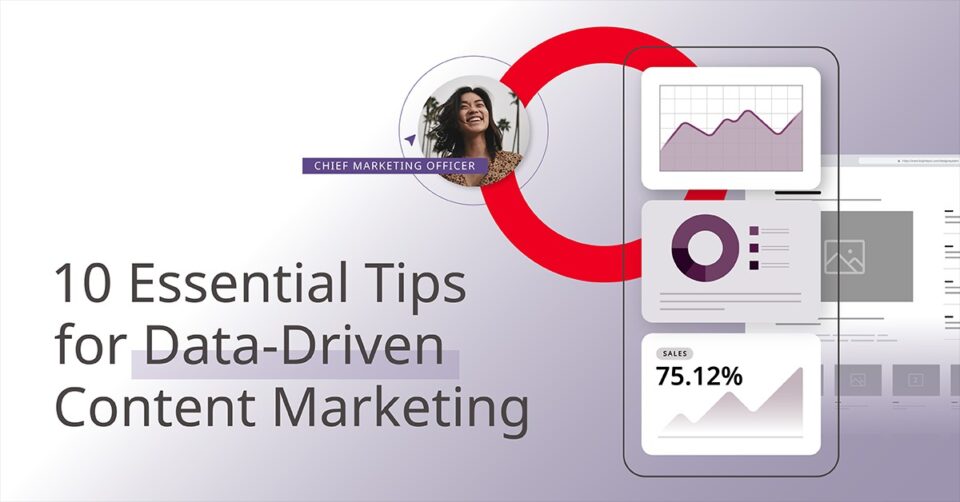Thanks to AI, any marketer can quickly create a blog post, article, or other Type of Content in minutes.
But whether that content resonates with your audience is another story — especially if you rely on AI keyword research and general ideas to drive your strategy. It may boost your search rankings, but it doesn’t necessarily build Brand Authority, create trustworthy connections, or have a positive marketing impact.
To achieve all of these goals through your content marketing efforts, you need to have a deep understanding of your audience’s needs. You also need the right data, including insights into who is accessing your content, what they want to achieve, and what content they engage with the most.
To help you achieve success, we’ve compiled 10 tips for leveraging data to sharpen your content marketing strategy. Follow these recommendations to create content that showcases your brand’s unique value and drives stronger marketing performance.
Tip 1: Go Beyond Basic Demographics
Don’t rely solely on age, gender, or location data to determine your content approach. Instead, dig deeper with research methods that help you better understand your audience’s behaviors, motivations, and interests.
This can be done through audience surveys, customer interviews, and social listening techniques. Useful insights can also be gleaned from your existing Website Analytics, customer feedback channels, and historical engagement data.
What you discover can show you ways to optimize your messaging, targeting, and channel selection.
Tip 2: Focus on topics, not just keywords
Yes, SEO is important. However, chasing high-volume keywords won’t necessarily improve your rankings or differentiate your content. Use insights from your audience data to create content that they’ll actually care about.
Start by applying the information you’ve gathered through the research techniques suggested above. For example, let’s say your data shows that your target audience wants advice on how they can benefit from machine learning. You can fill that knowledge gap with topically resonant content optimized to drive search traffic to your company’s website.
Tip 3: Align with sales and customer success
Your company’s sales and customer service teams regularly interact with members of your target audience, making them valuable sources for content insights.
These institutional partners have direct access to insights such as:
- Consumer FAQs
- Common Objections They Encounter
- Behavioral trends and preferences they observed
- How your current customers use (or intend to use) your products and services.
Ask them to share what they learned through their conversations with customers. Then use that to inform your decisions about topics and ideas you want to write about. It will help your content better address real-world challenges, and your internal teams can leverage that content in their outreach efforts.
Tip 4: Develop core content first
Choosing specific content types and topics can be overwhelming. There are millions of conversations you can create — how do you know where to start?
Take a cue from the knowledge you’ve gathered by following the three tips above: Look at the data you’ve collected, narrow down your topic list, identify who your target audience is, and create a blueprint for the overall content marketing strategy you plan to use.
Start with content that highlights your unique value proposition and solves your audience’s key problems. Then create additional content to support your overall strategy.
Core content can vary depending on how established your brand is. Newer brands should cast a wide net with content designed to raise brand awareness. Brands that are already well-known or have built a large following may want to prioritize bottom-of-the-funnel topics to connect with consumers who are ready to convert.
Tip 5: Create a logical content hierarchy
Use web analytics to structure your content experiences to help guide your audience through their buying journey. You can analyze data to identify common questions to create FAQ and how-to content because people are often looking for answers and are more likely to engage with your content if you provide useful information.
Additionally, focusing on evergreen content—content that remains relevant over time and can be easily updated, according to your data—should be a key part of your core content. Structure it to lead your audience to specific content they’re likely to show interest in. Include Q&As, how-to articles, content clusters, and evergreen topics to engage your audience in their specific areas of interest.
Tip 6: Publish with purpose and update existing content
Your strategy should include a distribution plan that targets specific audiences for key topics. This will help your audience discover the right content at the right time to influence their decision making.
Know why you published each piece and where it will be most effective. Continue to use this as a guide for future content.
The world of content is a constantly changing place — sometimes rapidly. That’s why monitoring your published content and periodically reviewing its performance data is just as important as publishing new content. You don’t want valuable information sitting on your site, gathering dust.
Over time, the information in your content may become outdated or your audience may demand new insights on the topic. Address these issues by updating or improving underperforming content before creating new content. Small updates can boost rankings and conversions.
Tip 7: Diversify and personalize content throughout the customer journey

What is personalization?
Create different types of content to appeal appropriately at each stage of the customer journey, from awareness to post-purchase support. This could include blogs, Social Media posts, infographics, and multimedia formats.
While demonstrating your expertise, don’t be afraid to turn your content into a fun and interactive experience for your customers. Creating content like surveys, personalized offers, quizzes, and events are great ways to demonstrate your brand’s expertise while also providing consumers with a fun and interactive experience to engage with.
Using a customer data platform (CDP) can help you deliver personalized content based on insights gathered through customers’ previous browsing, engagement, and purchasing behavior.
Tip 8: Publish consistently and prioritize human resonance
Quality is important, but volume and tempo are also important. According to HubSpot Research Publishing 5-10 articles per month will provide a good ROI and help you keep your content relevant and your website traffic consistent. This also continually checks the keywords your audience is frequently searching for, providing your SEO with additional data.
Pay attention to your ROI. This content performance metric can inform your posting frequency and allow you to try new ideas. Simply put, if some posts are more popular than others, you can decide to focus on creating more content around those high-performing topics.
Use AI to research and generate ideas, but still rely on human creativity to write. AI is great for research purposes, but it takes away the human aspect of the content, so make sure to include well-written pieces that will resonate with your audience. Incorporate customer reviews, testimonials, and social media posts to add authenticity and credibility to your content.
Tip 9: Test Everything
Use A/B testing to find out what works best in your content, design, CTAs, and delivery methods. Test layout, design, headlines and subheads, and other pieces of content and see what impact they have on your organizational goals.
Tip 10: Centralize content management
Use a modern CMS to manage, publish, and measure your content performance across all channels. This will help maintain consistency and allow you to personalize content at scale.
Remember to adapt to the ever-changing trends in content creation. You will need to adjust accordingly to best reach your target audience. By following these tips, you will have a data-driven content marketing strategy that truly connects with your audience and drives results.
Comment Policy: We truly value your comments and appreciate the time you take to share your thoughts and feedback with us. Note: Comments that are identified as spam or purely promotional will be removed. To enhance your commenting experience, consider creating a Gravatar account. By adding an avatar and using the same Email here, your comments will feature a unique and recognizable avatar, making it easier for other members to identify you. Please use a valid email address so you can receive notifications when your comments receive replies.
